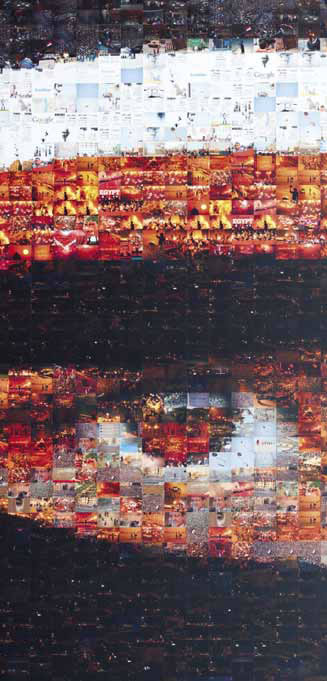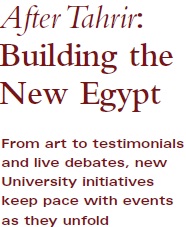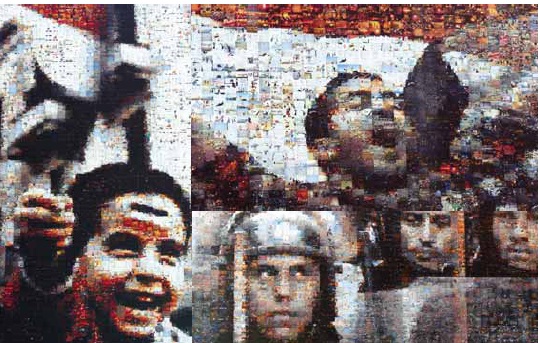 |  |
Photos by Ahmad El-Nemr
As engaged members of the Egyptian community,
AUC faculty, staff, alumni and students are
working to help build Egypt's future. Under the
theme of After Tahrir: Building the New Egypt, AUC has
launched a number of initiatives on campus to integrate the
revolution into the academic and cultural life of the
University, as well as to address critical issues facing the
country as it transitions to democracy. From panel
discussions, public lectures and new courses to oral history
documentation and student exhibitions, these postrevolution
initiatives –– born out of the 18 days in Tahrir–– show no sign of dwindling.
Of these initiatives, the exhibition titled Tahrir: 18 Days
that Changed the World is one of the most apparent. The
culmination of a student-led initiative and semester-long
independent study, the exhibition features more than 20
mosaic murals at the Conference and Visitor Center, near
Bassily Auditorium, ranging in size from 3 by 4 meters to
more than 7 by 14 meters. "The murals largely emphasize
the emotions of the revolution, starting with joy," explained
David London, who served as assistant professor of
journalism and mass communication last spring and
supervised the student project. "As viewers enter the
Conference and Visitor Center, they see murals that portray
emotions such as frustration, anger, pride and sorrow."
The distinctive appearance of the murals comes from the
fact that they are made up of thousands of smaller pictures
of varied color, contrast and tone. "Over the course of the
semester, students collected more than 12,000 pictures of the revolution. We then used a freeware
program to format the images and
arrange them to create the larger ones,"
said London, adding that the murals are
an attempt to keep the spirit of the
revolution alive, as well as emphasize
the role of women and youth in the
uprising. "We hope to channel the
energy and enthusiasm of the
revolution into the work needed to
build a new Egypt," he noted.

Mosaic murals on campus portraying emotions of the January 25th revolution are part of a number of post-revolution initiatives at AUC
In addition to art, the past semester
has also provided an opportunity for
well-known figures and leading activists
to speak at AUC through various
lecture series on campus. These include
Tahrir Dialogue, a series of debates,
organized by the School of Global
Affairs and Public Policy, on the key
issues facing Egyptian citizens as they
define a way forward; Transforming
Egypt, panel discussions held by the
School of Business to explore the
business and economic ramifications of
the revolution; as well as Egypt in
Transition: Know Your Role, a public
seminar series organized by the John D.
Gerhart Center for Philanthropy and
Civic Engagement to raise awareness
among Egyptians of their civic rights
and obligations. In addition, new
courses have been introduced and old
ones adjusted to reflect the changing
political, social and economic
conditions in Egypt. In response to the
changing work environment, AUC's
continuing and executive education
institutions also developed a portfolio
of training programs for business,
government and civil society.
Another post-revolution project launched by AUC is University on the Square, through which the experiences of AUCians in the revolution are documented through photographs, videos, testimonies and other digital material online, in addition to oral history recordings and designated collection centers for the donation of physical items.
Students have also taken the lead,
with the hosting of the seventh
annual Leadership for Education and
Development conference titled Masr
Tela'et Omy [Egypt Turned Out to Be
My Mother], which focused on the
empowerment of Egyptian youth and
brought leading figures to campus
including presidential candidates
Mohamed ElBaradei, Amre Moussa
and Abdel-Moneim Abul-Fotouh.
The conference also served as a
valuable opportunity for students to
network with professionals, politicians
and academics.
By Madeline Welsh